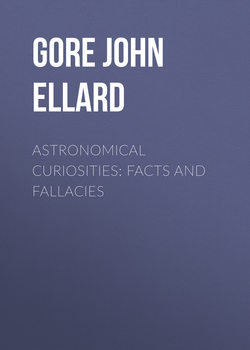Astronomical Curiosities: Facts and Fallacies

Реклама. ООО «ЛитРес», ИНН: 7719571260.
Оглавление
Gore John Ellard. Astronomical Curiosities: Facts and Fallacies
PREFACE
CHAPTER I. The Sun
CHAPTER II. Mercury
CHAPTER III. Venus
CHAPTER IV. The Earth
CHAPTER V. The Moon
CHAPTER VI. Mars
CHAPTER VII. The Minor Planets
CHAPTER VIII. Jupiter
CHAPTER IX. Saturn
CHAPTER X. Uranus and Neptune
CHAPTER XI. Comets
CHAPTER XII. Meteors
CHAPTER XIII. The Zodiacal Light and Gegenschein
CHAPTER XIV. The Stars
CHAPTER XV. Double and Binary Stars
CHAPTER XVI. Variable Stars
CHAPTER XVII. Nebulæ and Clusters
CHAPTER XVIII. Historical
CHAPTER XIX. The Constellations393
CHAPTER XX. The Visible Universe
CHAPTER XXI. General
Отрывок из книги
Some observations recently made by Prof. W. H. Pickering in Jamaica, make the value of sunlight 540,000 times that of moonlight. This makes the sun’s “stellar magnitude” minus 26·83, and that of moonlight minus 12·5. Prof. Pickering finds that the light of the full moon is equal to 100,000 stars of zero magnitude. He finds that the moon’s “albedo” is about 0·0909; or in other words, the moon reflects about one-tenth of the light which falls on it from the sun. He also finds that the light of the full moon is about twelve times the light of the half moon: a curious and rather unexpected result.
M. C. Fabry found that during the total eclipse of the sun on August 30, 1905, the light of the corona at a distance of five minutes of arc from the sun’s limit, and in the vicinity of the sun’s equator, was about 720 candle-power. Comparing this with the intrinsic light of the full moon (2600 candle-power) we have the ratio of 0·28 to 1. He finds that the light of the sun in the zenith, and at its mean distance from the earth, is 100,000 times greater than the light of a “decimal candle” placed at a distance of one metre from the eye.1 He also finds that sunlight is equal to 60,000 million times the light of Vega. This would make the sun’s “stellar magnitude” minus 26·7, which does not differ much from Prof. Pickering’s result, given above, and is probably not far from the truth.
.....
Schröter of Lilienthal – the famous observer of the moon – saw the horns of the crescent of Venus extended many degrees beyond the semicircle on several occasions in 1784 and 1795, and the border of the dark part faintly lit up by a dusky grey light. On February 14, 1806, at 7 P.M. he saw the whole of the dark part visible with an ash-coloured light, and he was satisfied that there was no illusion. On January 24 of the same year, 1806, Harding at Göttingen, using a reflector of 9 inches aperture and power 84, saw the dark side of Venus “shining with a pale ash-coloured light,” and very visible against the dark background of the sky. The appearance was seen with various magnifying powers, and he thought that there could be no illusion. In fact the phenomenon was as evident as in the case of the moon. Harding again saw it on February 28 of the same year, the illumination being of a reddish grey colour, “like that of the moon in a total eclipse.”
The “secondary light” was also seen by Pastorff in 1822, and by Gruithuisen in 1825. Since 1824 observations of the “light” were made by Berry, Browning, Guthrie, Langdon, Noble, Prince, Webb, and others. Webb saw it with powers of 90 and 212 on a 9·38-inch mirror, and found it “equally visible when the bright crescent was hidden by a field bar.”42
.....